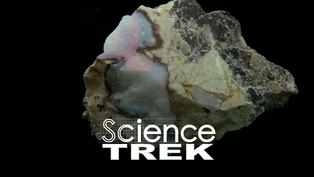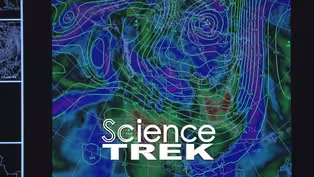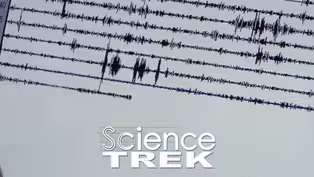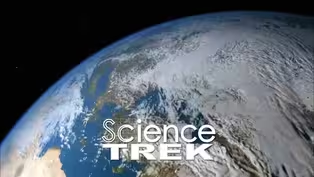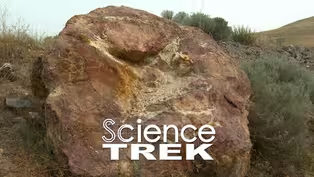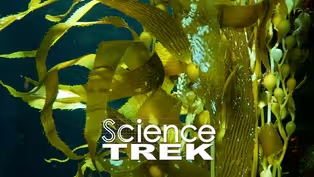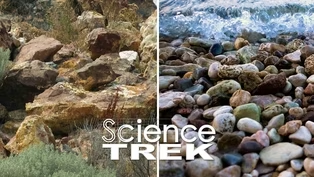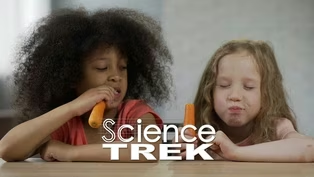
Rocks and Minerals: Rocks Your World
Special | 4m 46sVideo has Closed Captions
Discover how rocks, minerals & the rock cycle change your world.
Join the Science Trek team to explore rocks and minerals! Discover how the Earth formed, the three types of rocks, the rock cycle, and how minerals shape our world—from concrete to toothpaste. Fun, science, and surprises await.
Problems playing video? | Closed Captioning Feedback
Problems playing video? | Closed Captioning Feedback
Science Trek is a local public television program presented by IdahoPTV
Major Funding by the Laura Moore Cunningham Foundation and Idaho National Laboratory. Additional Funding by the Friends of Idaho Public Television and the Corporation for Public Broadcasting.

Rocks and Minerals: Rocks Your World
Special | 4m 46sVideo has Closed Captions
Join the Science Trek team to explore rocks and minerals! Discover how the Earth formed, the three types of rocks, the rock cycle, and how minerals shape our world—from concrete to toothpaste. Fun, science, and surprises await.
Problems playing video? | Closed Captioning Feedback
How to Watch Science Trek
Science Trek is available to stream on pbs.org and the free PBS App, available on iPhone, Apple TV, Android TV, Android smartphones, Amazon Fire TV, Amazon Fire Tablet, Roku, Samsung Smart TV, and Vizio.
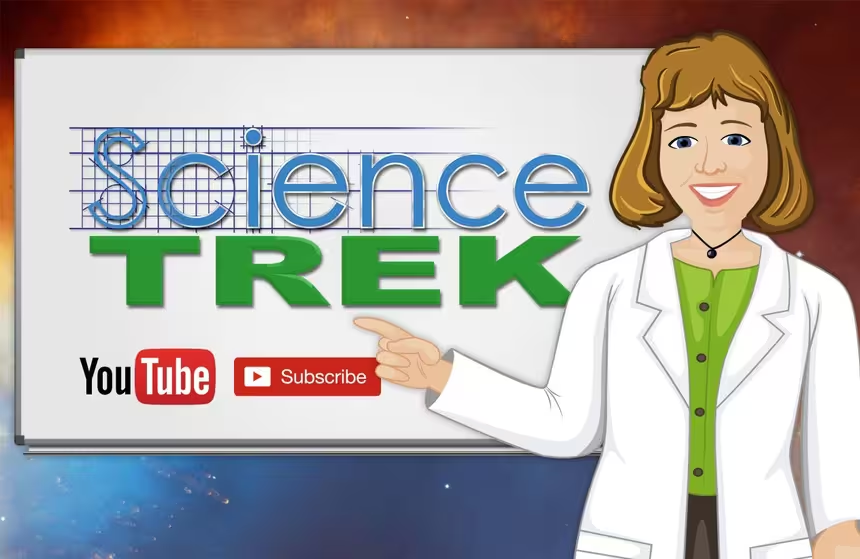
Science Trek
Science Trek is a place where parents, kids, and educators can watch short, educational videos on a variety of science topics. Every Monday Science Trek releases a new video that introduces children to math, science, technology, engineering, and math (STEM) career potentials in a fun, informative way.More from This Collection
Scientists study the earth and its atmosphere in many different ways. Some look at the physical characteristics, like rocks. Others study water or air. Earth Science helps us better understand the world around us and can help keep us safe. Find out more about the Earth.
Rocks and Minerals: Hidden Gems
Video has Closed Captions
How do scientists decide what is a gemstone? (6m 50s)
Weather: Meteorologists At Work
Video has Closed Captions
How do meteorologists forecast the weather? (5m 13s)
Earthquakes: A Whole Lot of Shaking Going On
Video has Closed Captions
An earthquake is a complicated process but knowing about it can save your life. (5m 11s)
Earthquakes: Seismographs, Pizza, and Football
Video has Closed Captions
Seismographs detect earthquakes, even human-caused quakes. (4m 41s)
Oceans: What's Under the Surface?
Video has Closed Captions
Oceans cover 70% of the Earth’s surface. Find out more about what’s under the surface. (7m 4s)
Oceans: Saving Kelp with AI and ROV
Video has Closed Captions
How do you use AI, ROV and an x-box joystick to save kelp? (6m 50s)
Video has Closed Captions
Find out how glaciers are created and their impact on our lives. (6m 15s)
Providing Support for PBS.org
Learn Moreabout PBS online sponsorshipJOAN CARTAN-HANSEN, HOST: Rocks and minerals tell the story of our Earth.
Let's see what the land you live on tells you about its history!
[MUSIC] Scientists think the universe formed 13.8 billion years in what's called the big bang.
[BOOM] Wait, let's not go back that far.
[REWINDING] The earth formed about 4.6 billion years ago.
The Earth has three main layers: the crust, which is between 3 and 50 miles thick, the mantle, and at the center is the core, with an inner core and outer core.
The crust and upper most mantle are broken into pieces called the tectonic plates.
The plates are always moving, but the fastest moves at about four inches or 10 centimeters a year.
There are three basic types of rocks in the earth's crust.
Igneous rocks are formed deep within the earth.
This molten rock is called magma.
When magma comes to the surface, it's called lava.
The lava flows or shoots out and cools as rock.
There're about 700 types of igneous rocks and they are generally hard and heavy.
Next are sedimentary rocks.
Sediment is a material made up of millions of small bits of rock that have been left behind by water or wind.
Sediment becomes solid rock when it gets buried, collecting over time and building up layers.
And over time and great pressure, the sediment gets squeezed together and makes a rock.
Sedimentary rocks include sandstone and limestone.
The third type of rock is metamorphic.
Metamorphic means change and that's what happens in this case.
Sedimentary or igneous rocks are changed by pressure and heat deep underground.
The minerals in the rocks change to new minerals and they become metamorphic rocks.
Metamorphic rocks include marble and slate.
New rocks are being made all the time.
It just takes millions of years.
It's called the rock cycle.
[rock guitar riff] Molten rock forms in the crust, hardening into an igneous rock.
Rain and wind break up the rock into pieces of sediment.
That's called erosion.
The sediment is carried away and settles eventually compressed into sedimentary rock.
That rock is driven underground where it is heated and squeezed into metamorphic rock.
That rock eventually melts and becomes igneous rock again.
And the whole cycle starts all over.
The rock cycle takes a very long time, but it's one of the reasons why the earth's surface is always changing.
It's also why earth is so special.
It's the only planet in our solar system with a rock cycle.
Almost all of the rocks on Earth are made up of minerals.
A mineral is a natural ingredient of the Earth, and a crystal is the special shape most minerals grow into.
Minerals or crystals are made up of 92 chemical elements joined together.
And you'll find them in all types of rocks.
Feldspar are a group of minerals found in about 50 percent of the Earth's crust.
Quartz and other silicants like clay are the next most abundant.
Minerals are important because we use them in everything from concrete to toothpaste.
Scientists who study rocks and minerals are call geologists.
They learn to read a rock record.
Sedimentary rocks have built up over millions of years into layers and geologist can look at those layers and figure out how long they've been there.
Geologists can also study the minerals in various rock beds to decide if there are valuable minerals there.
We get some minerals mostly by mining.
[EXPLOSION] So those are some of the basic facts about rocks and minerals.
Go and search a little, you can find some amazing rocks and minerals in your own neighborhood.
You never know what you'll find.
If you want to learn more about rocks and minerals, check out the Science Trek website.
You'll find it at ScienceTrek.org.
[MUSIC] ANNOUNCER: Presentation of Science Trek on Idaho Public Television is made possible through the generous support of the Laura Moore Cunningham Foundation, committed to fulfilling the Moore and Bettis family legacy of building the great state of Idaho, by the Idaho National Laboratory, mentoring talent and finding solutions for energy and security challenges, by the Friends of Idaho Public Television, and by the Corporation for Public Broadcasting.
Rocks and Minerals: Rocks vs. Stones
Video has Closed Captions
Clip: Special | 1m 4s | What is the difference between a rock and a stone? (1m 4s)
Rocks and Minerals: A Mouthful of Minerals
Video has Closed Captions
Clip: Special | 1m 4s | Hiding in your house are a whole lot of minerals. Find them! (1m 4s)
Providing Support for PBS.org
Learn Moreabout PBS online sponsorship
- Science and Nature

Explore scientific discoveries on television's most acclaimed science documentary series.

- Science and Nature

Capturing the splendor of the natural world, from the African plains to the Antarctic ice.












Support for PBS provided by:
Science Trek is a local public television program presented by IdahoPTV
Major Funding by the Laura Moore Cunningham Foundation and Idaho National Laboratory. Additional Funding by the Friends of Idaho Public Television and the Corporation for Public Broadcasting.
